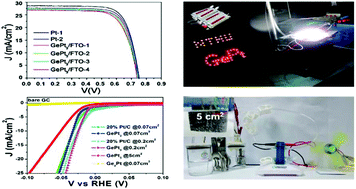Synthesis of germanium–platinum nanoparticles as high-performance catalysts for spray-deposited large-area dye-sensitized solar cells (DSSC) and the hydrogen evolution reaction (HER)†
Abstract
GePt3 and Ge2Pt nanoparticles were synthesized via a solution colloidal method as catalysts for dye-sensitized solar cells (DSSC) and the hydrogen evolution reaction (HER). The shape, size, arrangement, phases and crystalline structures of Ge–Pt nanoparticles were determined, and the ability to be dispersed in nonpolar solvents enabled them to form a catalyst ink with a stable ejection for the spray coating technique. A series of electrochemical analyses confirmed the catalytic properties of Ge–Pt nanoparticles toward the I−/I3− redox reaction system. The DSSC using GePt3 nanoparticles as the counter electrode exhibited excellent power conversion efficiency (PCE) of 8.04% at 0.16 cm2, which was comparable to that of a DSSC using Pt as the counter electrode (8.0%); it also exhibited an average PCE of 7.26% even at a large working area (2 cm2). In addition, the GePt3 catalyst exhibited excellent HER electrocatalytic performance with a large current density and a low Tafel slope, and it could stably operate at a working area of up to 5 cm2 with a low over potential (<0.06 V) to achieve 10 mA cm−2 cathodic current. This study provides fundamental insights into the preparation of germanium–platinum intermetallic compound catalysts at the nanoscale, which can be beneficial for the design and development of clean energy devices.



 Please wait while we load your content...
Please wait while we load your content...